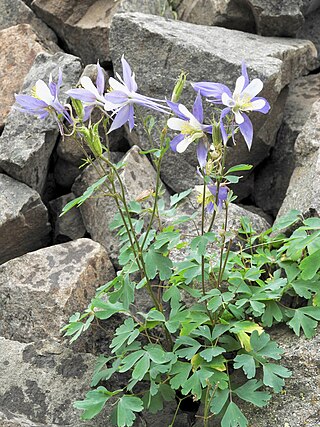
Aquilegia coerulea, the Colorado columbine, Rocky Mountain columbine, or blue columbine, is a species of flowering plant in the buttercup family Ranunculaceae, native to the Rocky Mountains and some of the surrounding states of the western United States. It is the state flower of Colorado. The Latin specific name coerulea means "sky blue".

Astragalus newberryi, is a flowering plant in the family Fabaceae, native to the western United States from Idaho to New Mexico and California. A variety is found in the Death Valley area and the eastern Mojave Desert in California and Nevada. It grows in rocky and gravelly areas between 1,300–2,350 metres (4,270–7,710 ft) elevation.

Apocynum androsaemifolium, the fly-trap dogbane or spreading dogbane, is a flowering plant in the Gentianales order. It is common across Canada and much of the United States excepting the deep southeast.
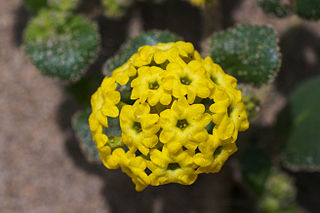
The perennial flower Abronia latifolia or Abronia arenaria is a species of sand-verbena known commonly as the coastal sand-verbena, or yellow sand-verbena. It is native to the west coast of North America, from southern California to southern British Columbia. In Canada, it is at risk of becoming extirpated, threatened, or endangered.

Primula pauciflora, the pretty shooting star, few-flowered shooting star, dark throat shooting star or prairie shooting star, is a species of flowering plant in the primula family Primulaceae. It is a widespread and very variable species, native to western North America, from Subarctic America to Mexico, often in xeric and desert habitats. It is found in the Great Basin Deserts and Mojave Desert. Its synonyms include Dodecatheon pauciflorum and Dodecatheon pulchellum.

Abronia villosa is a species of sand-verbena known by the common names desert sand-verbena and chaparral sand-verbena. It is in the four o'clock plant family (Nyctaginaceae). It is native to sandy areas in the deserts of the southwestern United States and northern Mexico, associated with creosote-bush and coastal-sage scrub habitats.

Abronia fragrans, the sweet sand-verbena, snowball sand-verbena, prairie snowball or fragrant verbena, is a species of sand verbena.

Penstemon deustus is a species of penstemon known by the common names hotrock penstemon and scabland penstemon. It is native to much of the northwestern United States from the Pacific Northwest to Wyoming, where it grows in many types of forest and open plateau habitat, often on soils heavy in volcanic rock or on limestone outcrops.

Penstemon eatonii is a species of flowering plant in the genus Penstemon, known by the common name firecracker penstemon. It is native to the Western United States from Southern California to the Rocky Mountains. It grows in many types of desert, woodland, forest, and open plateau habitat.

Hesperidanthus barnebyi, syn. Schoenocrambe barnebyi, is a species of flowering plant in the mustard family, known by the common names Barneby reed-mustard, Syes Butte plainsmustard, and Barneby thelypody. It is endemic to Utah in the United States, where it is known only from Emery and Wayne Counties. It is threatened by habitat degradation and destruction. It is federally listed as an endangered species of the United States.
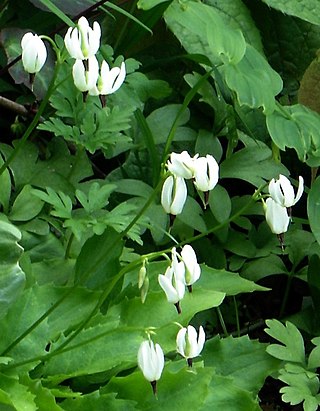
Primula latiloba, synonyms Dodecatheon dentatum and Dodecatheon latilobum, is a species of flowering plant in the family Primulaceae, known by the common names white shooting star and toothed American cowslip.
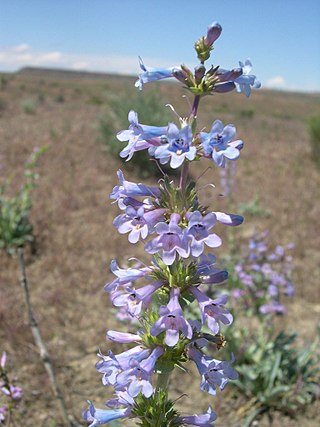
Penstemon acuminatus is a species of flowering plant in the plantain family known by the common names sharpleaf penstemon and sand-dune penstemon. It is native to the dry interior of the northwestern United States.

Penstemon angustifolius is a perennial semi-evergreen forb belonging to the plantain family. This species is 1 out of roughly 273 species of Penstemon. This species is also known as broadbeard beardtongue. This forb is native to central United States and can be noticed by its brightly and highly variable colored flowers.

Tetraneuris acaulis is a North American species of flowering plants in the sunflower family. It is known by many common names in English including stemless four-nerve daisy, stemless hymenoxys, butte marigold, and stemless rubberweed.

Allium douglasii, the Douglas' onion, is a perennial herbaceous flowering plant in the Amaryllidaceae family. It is native to northeastern Oregon, eastern Washington, and northern Idaho.
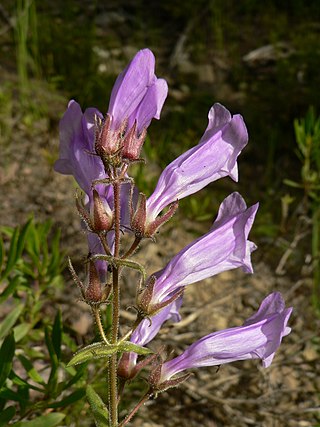
Penstemon fruticosus, the bush penstemon or shrubby penstemon, is a species of penstemon native to the Pacific Northwest of North America.
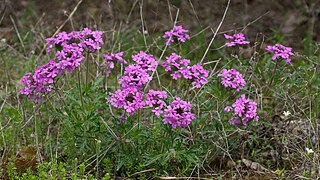
Verbena canadensis, commonly known as rose mock vervain, rose verbena, clump verbena or rose vervain is a perennial herbaceous flowering plant in the verbena family (Verbenaceae) with showy pink to purple flowers.. It is native to the eastern and south-central areas of the United States. This species is widely cultivated as an ornamental, and naturalized populations have been established outside its native range, such as in the northeastern U.S.

Mertensia lanceolata, known as prairie bluebells, lance-leaved bluebells, lance-leaved lungwort, and narrow-leaved languid ladies is a species of flowering plant native to the Rocky Mountains and areas of the northern Great Plains in western North America. A herbaceous perennial it has blue-green leaves alternately arranged on its smooth flowering stalk. Its flower buds are pink-purple and become blue as they open.
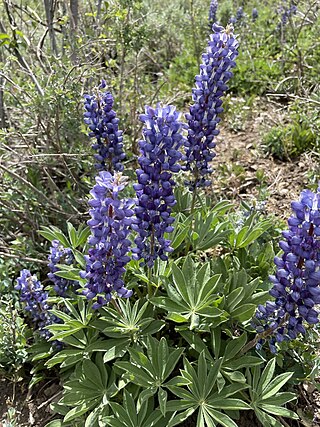
Lupinus prunophilus, commonly known as the hairy bigleaf lupine or chokecherry lupin, is a medium-sized herbaceous plant that grows in the Great Basin and other parts of the U.S. interior between the Sierra-Nevada and the Rockies. It is a close relative and very similar to Lupinus polyphyllus and is considered a subspecies by some botanists.

Penstemon arenicola, commonly known as Red Desert penstemon, is a species of plant from the Western United States. It primarily grows in Wyoming, but it also grows in small areas of Colorado and Utah. It is a short plant known for growing in sand as referenced by its scientific name.




















